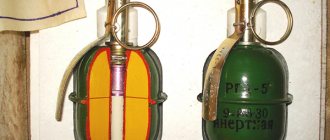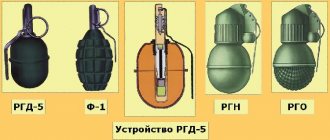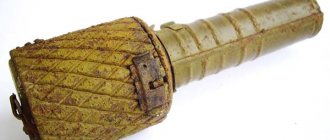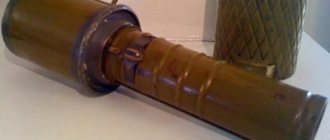Share the news with your friends
Grenade (Italian granata from Latin granatus - granular) is an explosive ammunition designed to destroy enemy personnel and equipment using hand throwing. To throw special rifle grenades and under-barrel grenades, the energy of gunpowder is used, which increases the throwing range many times - from 50 meters for a hand throw to 400 - 2,000 meters (for rifle and under-barrel grenades, respectively). Hand grenades can also be used to hit an enemy without throwing them by using tripwire mines. The main grenades in service with the Armed Forces of the Russian Federation and the countries of the former USSR are the RGD-5, F-1, RGO and RGN grenades, which will be discussed below.
RGD-5 grenade
RGD-5 - (hand grenade, remote, GRAU Index - 57-G-717) - Soviet hand grenade, belongs to the anti-personnel fragmentation hand grenades of the offensive type. This means that it is designed to destroy enemy personnel with hull fragments during an explosion.
The grenade reaches its target by throwing it with the hand.
Remote action - means that the grenade will explode after a certain time (3.2 - 4.2 seconds) after it is released, regardless of other conditions.
Offensive type - means that the grenade fragments have a small mass and fly at a distance shorter than the possible throw range.
Characteristics of RGD-5
Weight, kg: 0.31; Length, mm: 114; Diameter, mm: 56.8; Explosive: TNT; Mass of explosive, kg: 0.11; Detonation mechanism: UZRG, UZRGM, or UZRGM-2 fuse; Ignition retarder burning time: 3.2-4.2 seconds.
Externally, the grenade has an oval body made of thin steel. The streamlined body is assembled from an upper and lower part, each of which includes an outer shell and a liner. The hole for the fuse is closed with a plastic stopper during storage. The weight of the grenade with the fuse is 310 g. The explosive charge is TNT weighing 110 grams. The scattering range of fragments is 30 meters.
The grenade fuse is universal, also suitable for RG-42 and F-1 grenades. Fuse brand: UZRG, UZRGM (from the second half of the 1950s), or UZRGM-2. All these fuses are interchangeable. RGD-5 and the fuse for it. The hole for the fuse in the grenade body is closed with a plastic plug to prevent dirt from getting in.
Application of RGD-5
To use a grenade, you need to straighten the antennae of the safety pin, take the grenade in your right hand so that your fingers press the lever to the body. Before throwing a grenade, insert the index finger of your left hand into the pin ring and pull out the pin. The grenade can continue to remain in the hand as long as desired, since until the lever is released, the firing pin cannot break the primer.
After choosing the moment of the throw and the target, throw the grenade at the target. At this moment, the lever will rotate under the influence of the striker spring, releasing the striker, and fly off to the side. The drummer will puncture the capsule and after 3.2-4.2 seconds an explosion will occur.
The RGD-5 grenade was adopted for service in 1954, replacing the RG-42 offensive grenade. The experience of World War II showed that the range of RG-42 fragments sometimes exceeded the throwing range, creating a threat of hitting the thrower.
The training and simulation modification of the grenade is called URG-N (training hand grenade - offensive).
Notes
- History of the Molotov Cocktail
- Bakhurin Yu. A. Bestiary of the Great War: Unknown military-technical projects of the Russian Empire // Rodina. 2014. No. 8. P. 42-46
- Enrique Lister. Memories of the national revolutionary war of the Spanish people // “New and Contemporary History”, No. 2, 1962. pp. 80-90
- M. Ascarante, H. Sandoval. 986 days of struggle. lane from Spanish M., Politizdat, 1964. p.72
- “ The rebels used guns as anti-tank weapons, as well as bundles of grenades and bottles filled with kerosene and gasoline.
” Summary of the military situation in Spain [October 29 - 30, 1936] // V. V. Kondrashev. History of domestic military intelligence. M., “Kuchkovo Pole”, 2014. p.287-288 - “When tanks enter the city...” // Popular Mechanics, No. 2 (88), February 2010
- Z. Abramov. Senior Lieutenant Sirchenko // “Red Star”, No. 204 (4054) dated September 4, 1938. p.3
- Khalkhin-Gol'39. / Sat., comp. G. P. Solonitsyn. M., publishing house DOSAAF USSR, 1989. p.141
- Felix Leonidov. “Tanks are burning from bottles!” // magazine "Weapons", No. 4, 2000. pp. 10-12
- Molotovin cocktail on keksitty Korialla
- (Finnish) Antony Beevor.
Taistelu Espanjasta. - Helsinki: WSOY, 2006. - P. 136. - ISBN ISBN 951-0-31934-1. - Semyon Fedoseev.
Tank destroyers of the Second World War. Anti-tank infantry weapons - rifles, grenades, grenade launchers. - M.: “Yauza”, “Eksmo”, 2014. - 336 p. — ISBN 978-5-699-68978-1. - A. Renkel.
“Molotov cocktail” // Inventor and innovator. - 2005. - May (No. 5). - pp. 12-13. — ISSN 0130-1802. - Molotov Cocktails & Satchel Charges
- ↑ 1 2
(fin.)
w:fi:Antero Uitto ja w:fi:Carl-Fredrik Geust.
Mannerheim-linja - talvisodan legenda. - Helsinki: w:fi:Ajatus Kirjat, 2006. - pp. 118–119. — ISBN ISBN 951-20-7042-1. - Rajamäki Factory Museum
- A. I. Chugunov. The border is fighting. M., Voenizdat, 1989. p.127
- I. I. Yakubovsky. The earth is on fire. M., Voenizdat, 1975. pp.41-42
- A. A. Parkhomenko, A. S. Fedorov. Fighting Science. M., Knowledge, 1990. p.124
- Zhuravlev V.
Kirill Maksimovich Saldadze - creator of the incendiary mixture
(unspecified)
. Access date: September 18, 2011. Archived April 17, 2013. - Krylov N.I.
It will never fade. — 2nd ed. - M.: Voenizdat, 1984. - P. 61. - Lyubimtsev V.V.
Questions and answers. - M.: Bustard, 1995. - ISBN 5-7107-0448-2. - Kaczynski A.
Explosive cocktail (Russian).
Online publication - Internet project InoSMI.RU
. Polska Zbrojna, Poland (1 October 2011). Date accessed: September 23, 2022. - Vodolagin M.A.
Stalingrad Arsenal // Victory Forge. Feat of the Home Front during the Great Patriotic War. — 3rd edition. - M.: Politizdat, 1985. - P. 120-152. - The Northover Projector // Peter Chamberlain, Terry Gander. Anti-Tank Weapons (World War 2 Fact Files). 1974. pages 43-44
- Molotov Cocktails // Peter Chamberlain, Terry Gander. Anti-Tank Weapons (World War 2 Fact Files). 1974. pages 61-62
- German Pionier 1939-45: Combat Engineer of the Wehrmacht (unspecified)
(unavailable link). Date accessed: October 4, 2022. Archived March 10, 2016. - ↑ 12
Lexikon der Wehrmacht - War Department Field Manual FM 23-30-1944 Hand and Rifle Grenades; Rocket, AT, HE, 2.36″
- ATF-National Firearms Act handbook
- 26 US Code § 5861 - Prohibited acts (undefined)
. - 'NATO 3′ Sentenced to More Jail Time After Prosecutors Rabidly Invoke Boston Bombing
- 18 US Code § 924 - Penalties (undefined)
. - Results of the work of the first day of the ninth session of the House of Representatives of the National Assembly of the Republic of Belarus of the fifth convocation
- National legal Internet portal of the Republic of Belarus
F-1 grenade
F-1 - hand-held anti-personnel defensive grenade. (GRAU index - 57-G-721)
Designed to defeat manpower in defensive combat. Due to the significant radius of scattering of fragments, it can only be thrown from behind cover, from an armored personnel carrier or from a tank.
Characteristics of the F-1 grenade
Diameter, mm: 55; Case height, mm: 86; Height with fuse, mm: 117; Grenade weight, kg: 0.6; Explosive mass, kg: 0.06-0.09; Explosive type: TNT; Fuse: UZRGM; Deceleration time, sec: 3.2-4.2; Throwing range: 35-40 m; Shrapnel damage radius: 50 m /// 200 m - safe distance; Fuse deceleration time: 3.2-4.5 sec; Number of fragments: up to 300 pcs.
The F-1 grenade is a hand-held anti-personnel, long-range defensive fragmentation grenade. Its design turned out to be so successful that it has existed to this day without fundamental changes. The design of the fuse was slightly changed and modified in order to increase operational reliability.
Manual - delivered to the target by throwing the soldier’s hand.
Anti-personnel - designed to destroy enemy personnel.
Fragmentation - damage is caused mainly by fragments of the metal body of the grenade.
Defensive - the radius of scattering of fragments exceeds the average range of throwing a grenade using the muscle strength of a fighter, which necessitates the need to throw a grenade from cover in order to avoid being hit by fragments of one’s own grenade.
Remote action - the grenade detonates some time after the throw (3.2...4.2 s).
Application of F-1
To use a grenade, you need to straighten the antennae of the safety pin, take the grenade in your right hand so that your fingers press the lever to the body. Before throwing a grenade, insert the index finger of your left hand into the pin ring and pull it out. The grenade can continue to remain in the hand for as long as desired until the lever is released, the firing pin cannot break the primer (in principle, if the need to throw a grenade has disappeared and the pin has not been thrown out, it can be inserted back (without releasing the lever!); after bending tendrils of pomegranate pins are suitable for normal storage). After choosing the moment of the throw and the target, throw a grenade at the target. At this moment, the lever will rotate under the influence of the striker spring, releasing the striker, and fly off to the side. The drummer will puncture the capsule and after 3.2 - 4.2 seconds an explosion will occur.
The grenade is designed to destroy manpower and unarmored vehicles. The damaging factors are the direct high-explosive action of the explosive and the fragments formed when the metal shell of the grenade is destroyed.
Also, F-1 grenades are often used when setting tripwires, this is due to the number of fragments, which increases the chances of hitting the enemy, and a reliable fuse, which will not be damaged by prolonged exposure to unfavorable conditions before the trap is triggered.
A combination of 2 F-1 grenades creates a tripwire, which also has some anti-sapper properties - it explodes when the cable (wire) is cut. In special forces, the F-1 grenade is “modified”; before installation as a trip wire, the detonating charge is cut off and the fuse is removed. Or they install an instant mine fuse of suitable size. Thus, they achieve an almost instantaneous explosion and deprive the enemy of 3.2 - 4.5 seconds. for salvation.
US legislation on Molotov cocktails
In the United States, manufacturing, receiving (transferring), carrying (transporting)[30], using and performing other actions with a Molotov cocktail without prior permission from the Bureau of Alcohol, Tobacco and Firearms for these actions is a crime[31].
For example, for producing Molotov cocktails and intending to use them during the NATO summit in Chicago in 2012, three US citizens were sentenced to 5, 6 and 8 years in prison[32].
Under US federal law, possession, carrying or use of Molotov cocktails (as well as certain other weapons) in any connection with violent crime or drug trafficking is punishable by a criminal offense of at least 30 years in prison, and in the event , if a person has previously been convicted of similar crimes committed with the use of any firearm, life imprisonment is imposed[33].
RGN grenade
RGN - OFFENSIVE hand grenade, anti-personnel fragmentation impact grenade. Designed to defeat manpower in battle.
Characteristics of RGN
Weight, kg: 290 g; Length, mm: 113 mm; Diameter, mm: 60 mm; Explosive: A-IX-1 (96% RDX, 4% wax) (plastic); Mass of explosive, kg: 97 g; Detonation mechanism: Ignition of the ULDS with a deceleration time of 3.2-4.2 s.
The radius of damage from grenade fragments is 15 meters, the radius of possible damage is 35 meters.
Application of RGN
The RGN fuse is cocked only 1.3-1.8 seconds after the safety lever is released. If during this time the fuse experiences a noticeable shock, it is dearmed and the grenade does not explode; this protects against accidents if a grenade is accidentally dropped nearby. Material from the Unfair Advantage community. Next, the fuse goes into a state in which the grenade explodes upon impact with the target. If the grenade explosion did not occur from an impact fuse (for example, when it hits deep snow or grass), then the grenade explosion occurs 3.2-4.2 seconds after the release of the clamping lever. Before throwing, you must first remove the safety ring by pressing the lever with your fingers to the body of the grenade. The combat grenade is painted an olive-grayish color.
The very first
Perhaps the term “pomegranate” means “fruit” and comes from the name of a famous fruit. According to other sources, this word was formed on behalf of the Spanish city of Grenada, and the soldier-grenade throwers began to be called grenadiers accordingly. It is not known exactly when the very first explosive grenades appeared. But already in 1274, during their landing in Japan, the Mongols of Kublai Khan used exploding shells, with the help of which they frightened the horses of the samurai and brought panic into their ranks. The famous English historian David Nicol in his fundamental study “Weapons and armor of the Crusades. 1050-1350" reports that throughout the Muslim East, so-called grenades are found, which look like small ceramic vessels in the shape of a heart with a hole in the top. They date back to the 13th-15th centuries, and traces of mercury fulminate, a fairly powerful explosive, were found on their walls. So it is quite possible that these were real grenades, which were thrown either by hand or with the help of a belt sling into the ranks of the enemy! In Korea, the first metal grenades appeared at the end of the 16th century, they began to be used in the fight against the Japanese invasion, and in medieval India, grenades made from bamboo cylinders filled with gunpowder were used even earlier, during the wars of Sultan Akbar. Banns were thrown at the feet of war elephants so that they would get scared and turn back. In Europe, hand grenades, which looked like metal balls, were cast from cast iron and weighed about two pounds (800 grams). Such grenades became widespread at the end of the 17th century, and during the 18th century they were used very widely. They were thrown again with their hands or with the help of hand-held mortar-grenade launchers, which were an ordinary gun with a flintlock and a short barrel into which a grenade was inserted from the muzzle.
RGO grenade
RGO (defensive hand grenade) - hand-held anti-personnel DEFENSIVE shock-remote.
Designed to defeat manpower in defensive combat.
The radius of destruction by grenade fragments is 50 meters, the radius of possible damage is 100 meters. In terms of performance characteristics, it is generally similar to the F-1 grenade, but unlike it, it has a combined impact-remote fuse.
Tactical and technical characteristics of the Russian Geographical Society
Type of grenade - hand-held anti-personnel fragmentation defensive shock-remote
Characteristics:
Weight: 530 g; Throwing range: 30 m; Ignition time: 3-4 seconds; Number of fragments: 700 pcs.; Self-destruction time: 3.2-4.2 seconds; Long cocking time: 1.3-1.8 sec.; The method of delivery to the target is only hand throw; The method of delivery to the target is “trip”, “trap”.
Application of RGO
A grenade is delivered to the target only by throwing it with the soldier’s hand.
A grenade explodes when the grenade hits a surface. The fuse is ubiquitous, that is, it does not matter which part of the grenade hit the surface, and the position of the surface (vertical, horizontal, inclined) does not matter. The only thing that matters is the deceleration speed of the grenade when it hits the surface. If it hits the surface of water or loose, freshly fallen snow, the fuse may not work.
In order to increase the safety of the grenade launcher and ensure that the grenade does not explode if it accidentally encounters an obstacle at a close distance from the grenade launcher, the fuse is cocked only after 1.3-1.8 seconds. after the safety lever is released (the grenade is thrown). That is, if the grenade hits something at this time, the explosion will not occur at all.
If the grenade explosion did not occur from the impact fuse (the grenade was not thrown, but the lever was released; the grenade is still in flight; the grenade fell into water or loose snow), then after 3.2-4.2 seconds after the safety lever is released, an self-destruction of a grenade by detonation. In this regard, the grenade works exactly the same as the F-1, RG-42, RGD-5 grenades.
Simply put, the effect of a grenade is exactly the same as that of old grenades, but if in the period of time from the moment of throwing between 1.3-1.8 - 3.2-4.2 seconds. the grenade hits something, then an explosion will occur from the impact. A combat grenade is painted an olive-grayish color; The training simulation grenade is painted black.
Download:
Hand grenades - Instruction (1971).djvu665 KB
Legislation of Belarus on “Molotov cocktails”
In Belarus in 2016, criminal liability was introduced for actions with a Molotov cocktail. The term “Molotov cocktail” is not directly mentioned in the laws of the country. However, a law adopted in April 2016 introduced the concept of “objects whose destructive effect is based on the use of flammable substances” into the Criminal Code. When discussing this law in parliament, it was also confirmed that in this case we are talking about a “Molotov cocktail”[34]. Article 295.3, introduced into the Belarusian Criminal Code in April 2016, establishes that “illegal manufacture, acquisition, transfer of possession, sale, storage, transportation, forwarding or carrying of objects, the destructive effect of which is based on the use of flammable substances” will be punished up to imprisonment for a period of up to 2 years (if the act was committed repeatedly or by a group of persons by prior conspiracy, then up to 5 years)[35].
Changes in tactics
Field battle tactics changed and grenades began to be used only in the defense of fortresses and boarding battles in the fleet. Exploding ammunition became the property of the artillery. They hurled themselves with the help of large guns - mortars along a hinged trajectory.
It is worth noting the bombing guns, thanks to which Nakhimov won the victory at Sinop. The fragmentation grenade was widely used in the Crimean War during the defense of Sevastopol in 1854-1855; the city suffered several bombings. At the same time, the first Molotov cocktails began to be used on the bastions.










